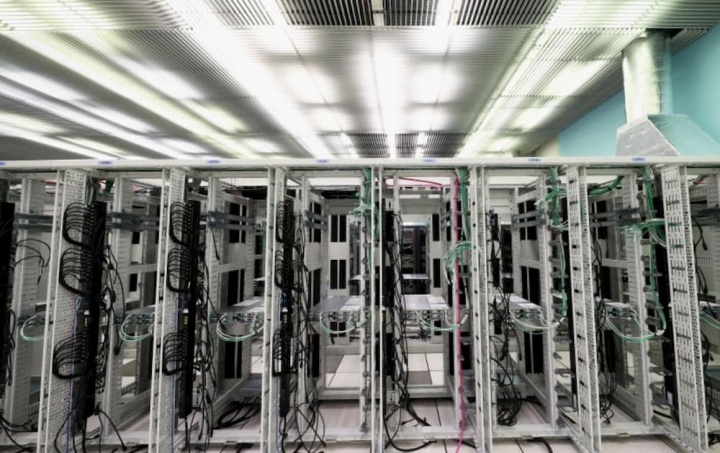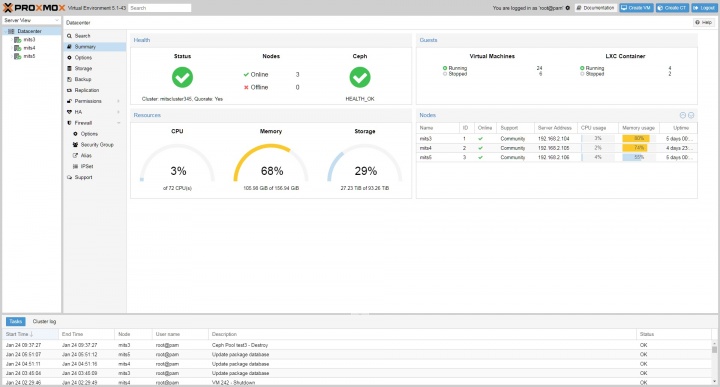Proxmox 6.0 – Fantástica Plataforma de virtualização gratuita
A Virtualização é uma das tecnologias que veio revolucionar os DataCenters, mas trouxe também uma nova vida à computação doméstica. No mercado são várias as plataformas de virtualização que existem tanto para ambientes domésticos como para ambientes empresariais, destacando-se neste segmento empresas como a Microsoft, VMWare e Citrix.
Para quem procura uma boa solução open source a nossa sugestão vai para o novo Proxmox 6.0.

O Proxmox destaca-se por ser uma solução open-source, que oferece suporte para a virtualização dos mais vastos sistemas operativos. Esta solução usa o hypervisor KVM (Kernel-based Virtual Machine) e containers lxc, permitindo realizar a gestão de máquinas virtuais, redes virtualizadas, armazenamento e HA (High Availability) Clustering.

Novidades do Proxmox 6.0
- Distribuição já baseada no Debian 10.0 Buster
- Linux kernel 5.0
- QEMU 4.0.0
- LXC 3.1.0
- Ceph 14.2 (Nautilus)
- ZFS 0.8.1
- Corosync 3.0.2
- Entre outras novidades.... ver aqui
Veja as novidades da nova versão em vídeo
Apesar do Proxmox VE ser uma solução mais virada para o segmento empresarial, podem facilmente experimentá-la em qualquer Desktop. O Pplware já disponibilizou aqui um tutorial que pode ajudar.
Leia também...
Este artigo tem mais de um ano























Pedro, o que faz exactamente um administrador de sistemas?
Pedro, o que faz exactamente um administrador de sistemas?
Que precisas de saber?
Qual é a diferença entre um administrador de sistemas e um devOP? Sem as questões filosóficas e questões de formalismos.
Qual é a diferença entre um administrador de sistemas e um devOP? Sem as questões filosóficas e questões de formalismos.
DevOps Engineer works with developers and the IT staff to oversee the code releases. They are either developers who get interested in deployment and network operations or sysadmins who have a passion for scripting and coding and move into the development side where they can improve the planning of test and deployment.
Network and computer systems administrators are responsible for the day-to-day operation of these networks. They organize, install, and support an organization’s computer systems, including local area networks (LANs), wide area networks (WANs), network segments, intranets, and other data communication systems.
Obrigado pela resposta Hugo, mas queria tbm a opinião do Pedro Pinto.
Esta resposta esta’ perfeita. DevOPS vs SysAdmin nao ‘e uma questao de “opiniao”. Sao conceitos e “profissoes”.
Why is it so hard to find DevOps engineers?
Because there is no such thing as a DevOps profession, in the same way that Agile is not a profession.
To say DevOps points to a “thing”, in the way that Front End or Backend maps to a piece of software development, would be using the term as a misnomer because DevOps is not a concrete job. To call someone a DevOps engineer is confusing, given that DevOps itself is a practice. In the tech industry, there is no such thing as an “Agile engineer”, only software engineers or PMs who are certified as Scrum masters. Why then, are there an influx of jobs looking for DevOps engineers?
DevOps has come to be known as a catch-all term for IT, cloud services, automation, testing, build systems, SRE, and anything that isn’t pure dev work. It seems that DevOps job listings are looking for folks who fit into all of these criteria. It’s impossible, though, for someone to be an expert in IT and cloud and automation/CI/CD and SRE and be an expert coder. If software organizations are confused about what DevOps engineers do, it’s because what they do is confusing, especially when so many job descriptions are lumped together for one person.
I propose that jobs looking for “DevOps” engineers should really evaluate the position that they are describing. Make these job descriptions clearer. Call them Automation Engineers, SREs, Delivery Experts, Infrastructure Engineers or just Software Engineer, depending on the job requirements. In order for a software organization to adopt DevOps, it needs a mix of these types of engineers and software engineers to be able to create the backend infrastructure for software to be run and shipped quickly.
Então Pedro, nao tens opinião?
Há comentários que a versão sem suporte não atualiza.
experimentei a versão anterior e não gostei de certas coisas não sei se melhorou nesta.
1 – não há instalação em RAID.
2 – não há suporte para BTRFS na instalação ou no GUI, apenas linha de comandos.
3 – O javascript alert irritante em cada 2 janelas de que estamos a usar uma versão gratuita e praticamente te obriga a fazer novo login.
4 – GUI lento e pouco intuitivo
5 – os modelos de subscrição por CPU Socket…